Five UNMC researchers have received this year’s Internal Medicine Research Awards for outstanding achievements and research accomplishments:
- Lynell Klassen, M.D. — Career Excellence Award, given to an established faculty member at the professor level for excellence in his or her research career.
- Paul Fey, Ph.D. — Basic Science Research Award, given to a junior or mid-level faculty member for excellence in a basic science research program.
- James O’Dell, M.D. — Clinical Research Award, given to a faculty member for excellence in a clinical research program.
- Scott Chapman, M.D. — Fellowship Research Award, given to a fellow for excellence in a research program.
- Todd Tessendorf, M.D. — Resident Research Award, given to a resident who has demonstrated excellence in a specific research project.
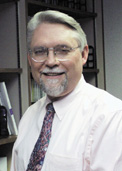 Dr. Klassen, professor, has had a distinguished career in research as evidenced by continuous funding from the National Institutes of Health and the Department of Veteran Affairs. He developed the Experimental Immunology Laboratory at the Omaha VA Medical Center and is a founding member of the Core Alcohol Research Center at the VA Medical Center. His research in the area of the immune responses to aldehyde-modified proteins, formed as a consequence of chronic alcohol consumption, is considered to be a major finding in the area of alcoholic liver disease, resulting in a national and international reputation. Dr. Klassen joined the UNMC faculty in 1982.
Dr. Klassen, professor, has had a distinguished career in research as evidenced by continuous funding from the National Institutes of Health and the Department of Veteran Affairs. He developed the Experimental Immunology Laboratory at the Omaha VA Medical Center and is a founding member of the Core Alcohol Research Center at the VA Medical Center. His research in the area of the immune responses to aldehyde-modified proteins, formed as a consequence of chronic alcohol consumption, is considered to be a major finding in the area of alcoholic liver disease, resulting in a national and international reputation. Dr. Klassen joined the UNMC faculty in 1982.
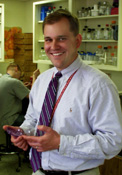 Dr. Fey, assistant professor and director of the molecular epidemiology section of the Nebraska Public Health Laboratory, is well recognized in several distinct research endeavors, including staphylococcal pathogenesis, beta-lactamase-mediated antibiotic resistance and salmonellosis. Because of his position in the Nebraska Public Health Laboratory, Dr. Fey became aware of an outbreak of antibiotic-resistant salmonellosis in western Nebraska. With his expertise in bacterial molecular genetics and antibiotic resistance, he characterized the resistance mechanisms and molecular epidemiology of the salmonella strain in question. Dr. Fey determined that the strain of salmonella was the most antibiotic resistant strain yet described in the Western Hemisphere and may have evolved in response to the use of antibiotics in animal food supplements or veterinary practice. He joined UNMC in 1997.
Dr. Fey, assistant professor and director of the molecular epidemiology section of the Nebraska Public Health Laboratory, is well recognized in several distinct research endeavors, including staphylococcal pathogenesis, beta-lactamase-mediated antibiotic resistance and salmonellosis. Because of his position in the Nebraska Public Health Laboratory, Dr. Fey became aware of an outbreak of antibiotic-resistant salmonellosis in western Nebraska. With his expertise in bacterial molecular genetics and antibiotic resistance, he characterized the resistance mechanisms and molecular epidemiology of the salmonella strain in question. Dr. Fey determined that the strain of salmonella was the most antibiotic resistant strain yet described in the Western Hemisphere and may have evolved in response to the use of antibiotics in animal food supplements or veterinary practice. He joined UNMC in 1997.
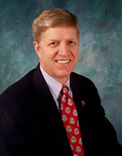 Dr. O’Dell, professor, chief of the section of rheumatology and vice chairman of the department of internal medicine, is internationally known for his work in investigating the best possible therapies for treating rheumatoid arthritis. After joining his alma mater in 1984, Dr. O’Dell formed the Rheumatoid Arthritis Investigational Network (RAIN) that has served as the basis for a number of his own studies and many cooperative investigations. The group has established a serum, plasma, urine and blood bank for investigational purposes. Dr. O’Dell’s original observations of genetic predictors of response to therapy have altered the way in which patients are treated and significantly contributed to the theories of how rheumatoid arthritis develops. These studies have been major contributions to the national and international scientific community.
Dr. O’Dell, professor, chief of the section of rheumatology and vice chairman of the department of internal medicine, is internationally known for his work in investigating the best possible therapies for treating rheumatoid arthritis. After joining his alma mater in 1984, Dr. O’Dell formed the Rheumatoid Arthritis Investigational Network (RAIN) that has served as the basis for a number of his own studies and many cooperative investigations. The group has established a serum, plasma, urine and blood bank for investigational purposes. Dr. O’Dell’s original observations of genetic predictors of response to therapy have altered the way in which patients are treated and significantly contributed to the theories of how rheumatoid arthritis develops. These studies have been major contributions to the national and international scientific community.
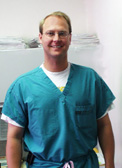 Dr. Chapman’s cardiology fellowship has revolved around collecting and analyzing data on the effect of microbubbles and cardiac ultrasound energy on the induction of arrhythmias. His work is being done in collaboration with Drs. Tom Porter and Feng Xie. It follows the observation that ventricular arrhythmias occurred as microbubbles were injected and imaged by cardiac ultrasound in an open-chested animal. Dr. Chapman’s project is an extension of this observation. Dr. Chapman did his residency at UNMC after graduating from UNMC in 1998. His background is in electrical engineering.
Dr. Chapman’s cardiology fellowship has revolved around collecting and analyzing data on the effect of microbubbles and cardiac ultrasound energy on the induction of arrhythmias. His work is being done in collaboration with Drs. Tom Porter and Feng Xie. It follows the observation that ventricular arrhythmias occurred as microbubbles were injected and imaged by cardiac ultrasound in an open-chested animal. Dr. Chapman’s project is an extension of this observation. Dr. Chapman did his residency at UNMC after graduating from UNMC in 1998. His background is in electrical engineering.
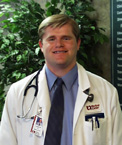 Dr. Tessendorf accomplished a great deal in August 2001 while serving as a UNMC resident. Dr. Tessendorf demonstrated the ability to grasp the concepts of the research in examining diagnostic and therapeutic applications of intravenous microbubbles. Dr. Tessendorf assisted on several projects and took the lead responsibility in exploring whether intracranial intravascular thrombi could be dissolved with trans-temporal ultrasound and microbubbles. His demonstration of the concept resulted in the abstract being accepted for an oral presentation at the 2002 American College of Cardiology meetings in Atlanta, Ga.
Dr. Tessendorf accomplished a great deal in August 2001 while serving as a UNMC resident. Dr. Tessendorf demonstrated the ability to grasp the concepts of the research in examining diagnostic and therapeutic applications of intravenous microbubbles. Dr. Tessendorf assisted on several projects and took the lead responsibility in exploring whether intracranial intravascular thrombi could be dissolved with trans-temporal ultrasound and microbubbles. His demonstration of the concept resulted in the abstract being accepted for an oral presentation at the 2002 American College of Cardiology meetings in Atlanta, Ga.